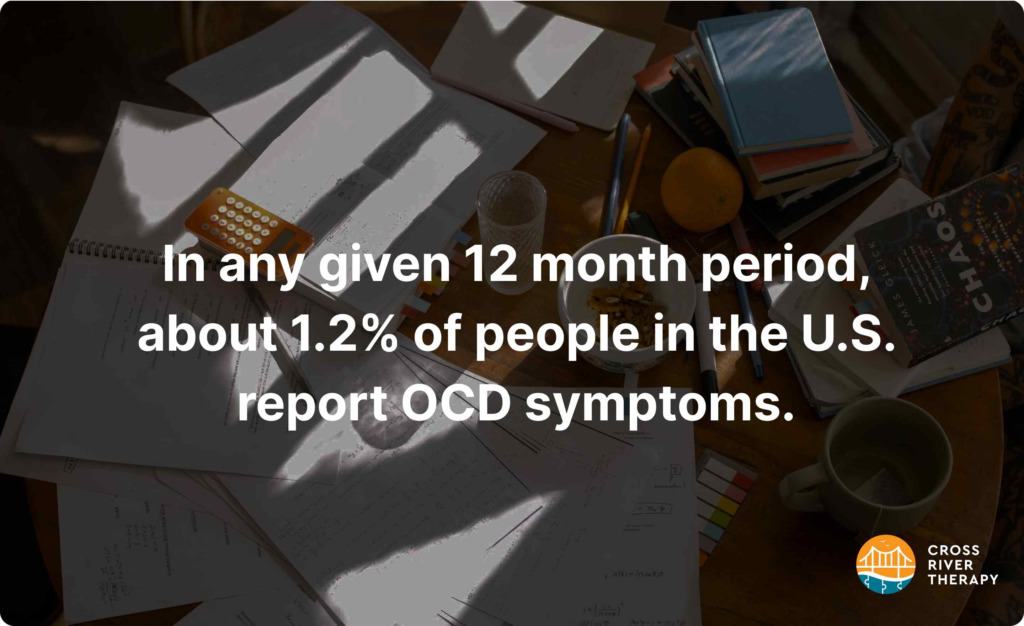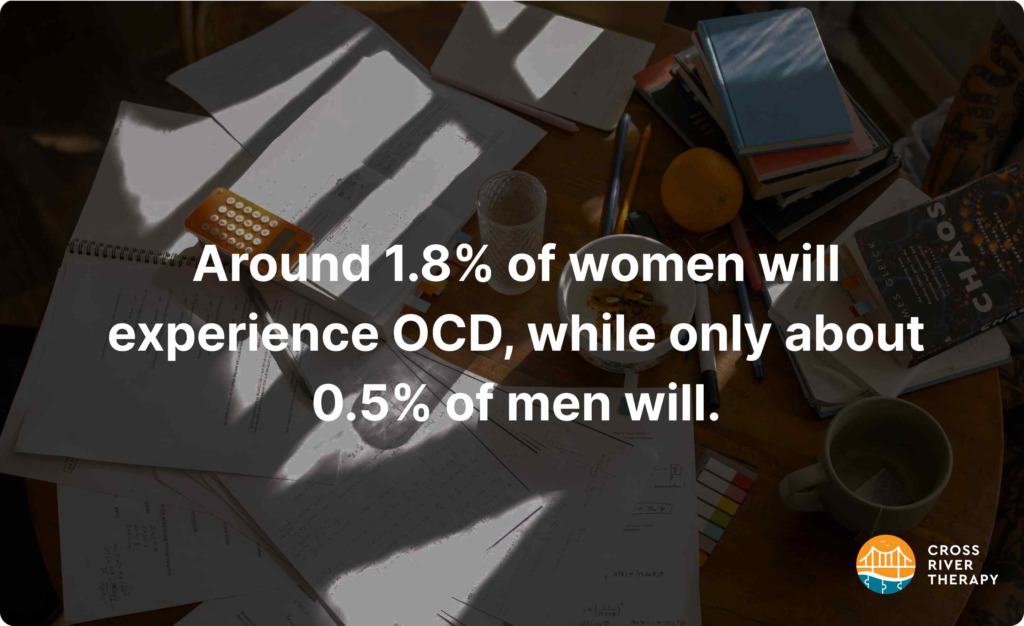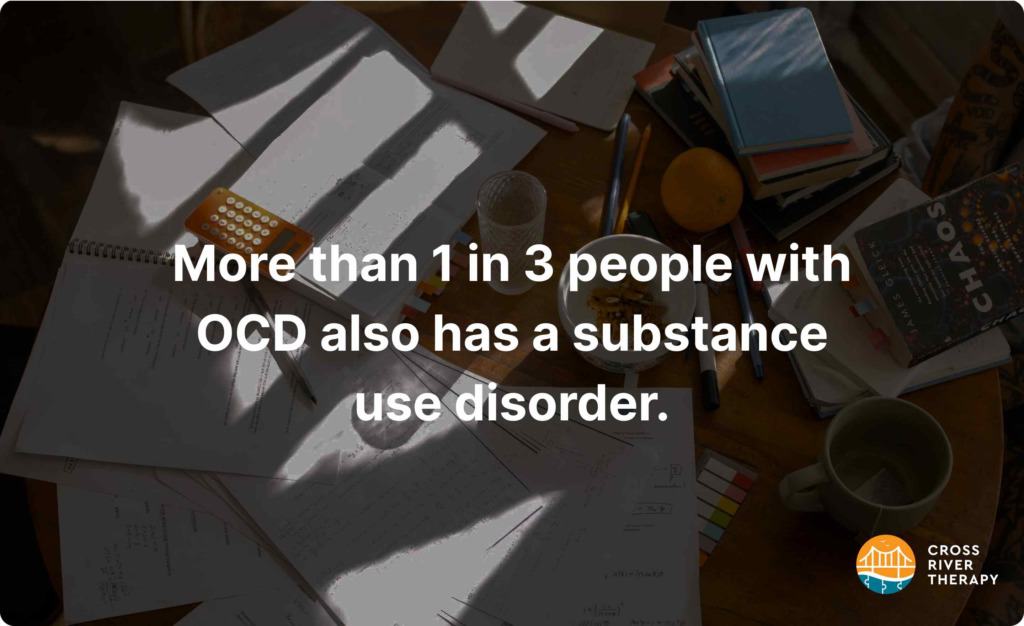57+ OCD Statistics: How Many People Have OCD?
Did you know that OCD affects 2.5 million adults or 1.2% of the U.S. population?

Key OCD Statistics: What Percentage Of People Have OCD?
- OCD affects 2.5 million adults or 1.2% of the U.S. population.
- At least 1 in 200 – or 500,000 – kids and teens have OCD. This is around the same number of kids who are diagnosed with diabetes.
- On average, people are diagnosed with OCD when they are 19-years-old.
- OCD has a worldwide prevalence of between 1% and 2%.
- In the United States, about 2.2% of the population will experience OCD sometime during their lives.
- Rates of OCD were found to be higher with women (1.8%) than men (0.5%).
- Childhood OCD has a stronger genetic link than adult-onset OCD, with up to 65% having a genetic link.
- About 25% of men with OCD develop their symptoms prior to the age of 10.
- 9 out of every 10 people with OCD have another mental health condition, with a co-occurring anxiety disorder being the most common.
- Only about 10% of people with OCD are fully cured of their symptoms, but about 50% do report symptom improvement with treatment.
- Over 50% of people with OCD report that their symptoms cause severe impairment, and 85% say they experience moderate to severe impairment.
- The country with the lowest prevalence of OCD in its population is Taiwan, with just 0.4%.

Chapter 1: How Common Is OCD?
- In the United States, about 1 in every 100 adults has OCD.
- About 1 in every 100 children in the United States have OCD.
- Studies indicate that about 1.8% of women will experience OCD symptoms in any given 12 month period, while only 0.5% of men will.
- According to a study published in 1992, about 2 out of every 3 adults with OCD first exhibited debilitating symptoms before they turned 25.
- When you have a family history of OCD, your chance of you or another family member developing OCD is about 25%.
OCD is fairly common, as far as mental health issues go. It isn't quite as common as problems like depression or generalized anxiety. People with OCD often have anxiety or depression as well.
Many of the studies on OCD were conducted in the 1990s and early 2000s. There hasn't been a lot more research into the prevalence of OCD over the past two decades. However, the prevalence does seem to have remained steady from the 1980s until now.
Most OCD research today is geared toward determining which treatments work. There have been major advances in OCD treatment with medication and different forms of therapy. That's great news, since OCD is debilitating for the vast majority of people who have it.
OCD Prevalence by Severity
- From 2001 to 2003, more than half of all adults struggling with OCD reported severely impairing symptoms.
- One out of every three people in the same study said that they were struggling with moderately impairing symptoms.
- More than 80% of people with OCD report moderate to severe impairment overall.
- In fact, only 15% of those with OCD said that their symptoms were mild, making this one of the most debilitating mental health conditions.
-

There aren't a lot of recent studies gauging the severity of OCD. Most of our best data comes from the early 2000s. But the severity of the illness is likely similar in 2022.
It's also possible that the COVID-19 pandemic may have increased symptom severity in people with OCD, as it did in people with other mental health issues.
One study showed that the rate of severe OCD became higher during the COVID-19 pandemic, indicating that the environment played a big role.
OCD is one of the most debilitating mental health conditions.
In order to be diagnosed, a person must spend at least one hour per day on their obsessions or compulsions.
But many people with OCD use much more time than that. They are also more likely to cancel social events, suffer at work, and experience extreme anxiety at home.
A mental health condition is severely debilitating when it interferes greatly with your quality of life. More than half of all people with OCD say that their symptoms have a severe impact. Only 15% say that their symptoms have a minimal impact on their quality of life.
This can also have a serious impact on a person's outlook. Data shows that about 36% of individuals with OCD have experienced suicidal thoughts at some point. About 11% report that they have attempted suicide at some point.
Though this number isn't as high as in illnesses like bipolar disorder, it is extremely high compared to the general population.
Suicide attempts can have lasting health effects, even if they aren't successful. People with OCD may also feel hopeless if they've tried multiple avenues of treatment without seeing many results.
OCD Prevalence by Country

- Statistics show that anywhere from 1.1% to 1.8% of the global population struggles with OCD.
- Within the United States, OCD prevalence is about 2.2% of the population, though only about 1.2% is diagnosed.
- In the United Kingdom, about 750,000 people have OCD, making up 1.2% of the population.
- In Australia, about 2% of the population has OCD, which comes out to 500,000 people.
- In Canada, the prevalence of OCD is just under 1%, coming in at 0.93%.
- The country with the lowest OCD prevalence in the world is Taiwan, where just 0.4% of the population struggles. Taiwan's population has also been shown to have a lower overall rate of psychiatric disorders.
- India has an OCD prevalence of just 0.6%, comparable to Taiwan's.
- New Zealand and Korea both have rates of 1.1%.
- Japan has a rate of 1.7%, while Iran and Puerto Rico both tie at 1.8%.
OCD is prevalent in about equal measure throughout the world. The average is somewhere from 1% to 2% of the population. There are a few outliers like Taiwan, where the rate of OCD is just 0.4%.
In the United States, about 1.2% of the population experiences OCD symptoms during a 12 month period. However, about 2.2% of the population will experience OCD at some point during their lives.
OCD Prevalence by Year

- In any given 12 month period, about 1.2% of people in the U.S. report OCD symptoms. Men have a rate of about 0.5%, while women have a rate of 1.8%.
- The first epidemic study of OCD in the U.S. determined that there was a prevalence of anywhere from 0.8% to 2.2% in any given year.
- In 1994, a study was done showing that the rate of prevalence was 0.8% to 2.3% in the U.S., but the study's methods were later questioned and debunked.
- The prevalence of OCD in the U.S. population has remained relatively stable from the first study in 1982 until today in 2022.
The stability in prevalence might indicate that OCD will continue to be a common condition. While it has been diagnosed with slightly more frequency in recent years, it hasn't grown at the same rate of disabilities like autism.
OCD's diagnostic criteria has also remained stable for the most part. People who would be diagnosed in 1980 would also be diagnosed in 2022.
There have been very few epidemiology studies of OCD in the 2010s or 2020s. However, the data from previous studies doesn't seem to have changed. Most OCD studies today are related to treatment and management, rather than epidemiology.
OCD Prevalence by Age

- OCD has an average age of onset of about 19.5 years, but there are children who develop the condition as well.
- Though women are more likely to have OCD than men, boys are far more likely to have early onset symptoms than girls.
- About 1 in 4 men with OCD first experience symptoms before they're 10 years old.
- Most women receive an OCD diagnosis during their adolescence, rather than as very young children.
- OCD tends to be more severe in those who develop it before age 10. Early onset also leads to higher comorbidity with bipolar disorder and ADHD.
- It is rare for people to develop OCD for the first time past age 30, although some people may experience a recurring of symptoms well into adulthood.
It's common for women to be diagnosed with OCD in their adolescence or their early twenties. Overall, the average age of onset is about 19.5 years.
That indicates that a good portion of people first show symptoms in their late teens or early twenties.
Furthermore, analysis has shown that people are unlikely to develop OCD for the first time after age 30. But if they had OCD as a child or teenager, it's possible that symptoms will recur intermittently after age 30. Only about 10% of people experience a full "cure" for their OCD, and everyone else has some symptoms throughout the rest of their lives.
It is possible for children under the age of 10 to develop OCD, though this is significantly more common in men than women. Children who develop OCD before the age of 10 are also likely to have ADHD, bipolar disorder, or both. Genetics play a larger role in childhood OCD than adult OCD.
OCD Prevalence by Gender

- Studies show that in any given 12 month period, about 1.8% of women will experience OCD, while only about 0.5% of men will.
- Other global studies indicate that men and women experience OCD at relatively similar rates.
- Men are much more likely to exhibit early childhood symptoms of OCD than women.
Research indicates that 98% to 99% of both men and women will never experience OCD. Global studies show that both genders tend to develop OCD with similar rates of prevalence.
However, some United States studies indicate that women might be at a slightly higher risk of developing OCD than men.
The age of onset is also affected by gender. While the average age of onset is 19.5 years in general, men are more likely to develop OCD at a young age.
Around 25% of men with OCD first developed their major symptoms before they turned 10. Women are significantly less likely to show symptoms before turning 10.
OCD Prevalence by Race
- One study showed that about 1.6% of Black people in the U.S. have OCD, compared to about 1.2% of the general population having OCD.
- The prevalence of OCD in different ethnicities has been rarely studied, with more than 90% of study participants tending to be white.
- Research does indicate that OCD occurs about equally in all ethnicities, but some may lack access to treatment due to healthcare, language, or economic barriers.
There has been very little research into the exact prevalence of OCD among different ethnic groups. But statistical analysis shows that OCD occurs similarly regardless of race or socioeconomic background.
It also occurs similarly in countries across the globe. One of the problems with the research is a lack of diversity in study participants.
One analysis of OCD research showed that only 2% of participants on average were Black, and over 90% of participants on average were white. That means that researchers in the United States have much more data on white patients than patients from other ethnic backgrounds.
Chapter 2: OCD & Co-Occurring Mental Health Conditions
- 9 out of every 10 people with OCD have also had another mental disorder at some point during their lives.
- About 76% of people with OCD have another anxiety disorder, such as a debilitating phobia, panic disorder, or PTSD.
- About 63% of people with OCD have a mood disorder like bipolar disorder or depression.
- More than half of people with OCD also have ADHD, with the prevalence being about 56%. Men who exhibit OCD symptoms in early childhood have a higher likelihood of being diagnosed with ADHD.
- More than 1 in 3 people with OCD also has a substance use disorder, with a prevalence of about 39%.

It's extremely common for OCD to present alongside other mental health conditions. In fact, it's more unusual for someone to have OCD alone. Only about 10% of individuals with OCD don't have another mental health issue.
More than 3 out of 4 people with OCD have a second anxiety disorder like PTSD or agoraphobia. The combination of these anxiety disorders can lead to more severe symptoms.
ADHD is extremely common in people with OCD, occurring in a little over 50% of patients.
Substance use disorders are also common in people with OCD. Oftentimes drugs or alcohol are used to self-medicate and deal with OCD symptoms. These disorders can be compounded when the person has additional anxiety or mood disorders.
Chapter 3: Causes of OCD
- The exact cause of OCD is not known, but researchers believe it involves a combination of environmental, neurological, and genetic factors.
- OCD may develop when people have abnormalities in their neurotransmitters, which are necessary for communicating between different portions of the brain.
- People with OCD may lack the serotonin necessary for the cerebral cortex to communicate with deeper portions of the brain.
- When people show OCD symptoms in childhood, their chances of genetic involvement are between 45% and 65%.
- When people show OCD symptoms in adulthood, their chances of genetic involvement are much lower, coming in at just 27% to 47%.
- There is a form of childhood OCD called PANDAS, which is caused by an autoimmune response following an infection.
There is no definitive answer about what exactly causes OCD. However, researchers have found that genetic and neurological differences may be involved.
You are more likely to develop OCD if it runs in your family. The neurological component of OCD may involve issues with communication between different portions of the brain.
One rare form of OCD occurs in childhood after an infection. This condition, called PANDAS, doesn't present like normal OCD.
It has an extremely rapid onset, with symptoms appearing seemingly overnight. The symptoms also have an extremely severe impact on the child's quality of life.
Chapter 4: Statistics on OCD Treatment & Recovery
- Despite 85% of people reporting that OCD has a moderate to severe impact on their lives, it takes an average of 9 years to be diagnosed.
- Older studies indicate that it can take 17 years after diagnosis to create an adequate treatment plan. However, this number may be lower today thanks to increased access to mental healthcare.
- About 10% of individuals with OCD make a full recovery and no longer have symptoms.
- About 90% of individuals with OCD will contend with symptoms for their entire lives, but 50% of people have reported that their symptoms have improved.
- OCD is treated using a combination of medication and therapy techniques like cognitive behavioral therapy and exposure therapy.
- It takes up to 12 weeks for SSRI medications to affect OCD symptoms, but the rate of success is up to 60%.
- Studies indicate that a new therapy called exposure and response prevention might be more effective at treating OCD than previous methods.
OCD treatment has evolved significantly over the past 20 years. As researchers learn more about the causes of OCD, they learn more about treating it.
For example, studies show that OCD is related to an imbalance of neurotransmitters. People with OCD might have too little serotonin to send messages throughout the brain.
Low serotonin can also cause depression and anxiety.
This is why SSRIs are one of the first medications used to treat OCD. It can take several months for them to have an effect, but between 40% and 60% of patients report improvement. Medication works best when it is used in combination with psychotherapy techniques like cognitive behavioral therapy.
Chapter 5: What Is OCD?
- OCD is a mental illness with a basis in neurobiology.
- The World Health Organization has listed OCD as the 10th most debilitating disease in existence in the past.
- People with OCD have obsessions and compulsions that cause significant distress and often severe impairment.
- Obsessions are thoughts, images, or fears that a person can't stop thinking about. Compulsions are behaviors that a person might act out in order to quell those fears or stop the obsession.
OCD is one of many anxiety disorders that can impact a person's life. It also commonly occurs alongside another anxiety disorder like panic attacks, PTSD, agoraphobia, or general anxiety.
OCD is one of the most debilitating mental health conditions in the world. About 85% of people with OCD have said that they experience moderate to severe impairment, with over half saying that their impairment is severe. Only 15% of people with OCD only experience mild symptoms.
People with OCD spend at least an hour a day on their obsessions and compulsions. Most spend significantly more time per day obsessing. The amount of time lost each day can add a lot to the distress.
Conclusion
OCD can be a debilitating mental illness, but there are ample resources available for treatment. We hope this has taught you a lot about OCD!
Sources

Have Any Questions?
Whether you're curious about our services or need support, we're just a click away. Reach out or check our FAQs for quick answers.

